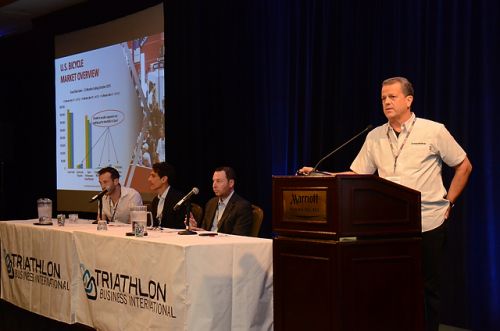MARINA DEL REY, Calif. (BRAIN) — The challenge of casting a wider net to continue to grow the sport of triathlon emerged as a key theme at Triathlon Business International's third annual North American Annual Conference held in Los Angeles this week.
Scott Brown, president of Universal Sports Network, described the importance of televising triathlon and other endurance sports in order to bring them to mainstream audiences in his opening keynote address. "The ability to tap in and access events in real time is a dramatic change," Brown said. "We just don't have to wait anymore, which expands what is possible in broadcasting endurance events, as is the ability to capture images via POV cameras and drones."
"It takes the viewership of sports past voyeurism," he added. "It lets the audience feel they are there and we can tell better stories to engage people."
Engaging current triathletes and grabbing the attention of new ones is the key to triathlon's growth. Although the sport has experienced phenomenal growth, adult participation numbers are flat according to USA Triathlon.
"Our sport is participant driven," said Rob Urbach, CEO of USA Triathlon. "We can make our sport more compelling and deliverable with content that is good for television sports and distribution in all channels. There is opportunity for recasting and taking advantage of new technology."
But besides televising more events, investing in youth and women's participation is an industry priority. Both segments are growing, especially youth triathlon. The USAT has launched several successful initiatives to engage kids and teens via school sports programs. "It's encouraging that 90 percent of these kids are staying in the sport," Urbach said. "But there is still so much we can do to invest in our youth."
Breaking down barriers to entry to bring more women into the sport is also a top priority for Life Time Fitness and Ironman, which recently announced a new nationwide effort called "Women For Tri" to do just that. Ironman and Life Time appointed a 12-member advisory board and an ambassador team to research, brainstorm and put into action strategies to help grow female participation.
And by hosting indoor triathlons and other women's events, the two organizations hope to attract more women to the sport. "The two most cited barriers to entry into triathlon for women are the open water swim and the cost of buying a bike," said Kimo Seymour, senior vice president of media and events for Life Time. "But by making it easy for first timers to do their first tri in a pool and riding whatever bike they can pull out of the garage, in a safe environment, I think we can get more women to try it."
Reaching underserved communities is also a priority for the industry. USAT has several pilot programs in place at the college level to help increase diversity and grow the sport. "It's an area we know we need to be working, looking at demographics," said Urbach. "It's partly cultural adaptation, and that will take time but we're working on it."
Triathlon has historically attracted affluent professionals — mostly male — with disposable income, and interim data from TBI and MultiSport Research's current U.S. Triathlon Marketplace Study suggests this is still true. According to data presented by MultiSport Research's Gary Roethenbaugh from nearly 2,200 participants that have responded so far, the triathlete's annual income averages around $105,000, and 70 percent of U.S. triathletes are male.
But other data supports the notion that it's beginning to shift as triathlon becomes more accessible to a wider audience via a growing number of clubs and local teams. "There is this stereotype of the narcissistic triathlete, but I think that is really starting to change," said the USAT's Rob Urbach. "Clubs and teams are forming, and if we can capture all that energy, it will be positive for the sport."
Leveraging the social side of what many perceive to be a solitary sport will be a key to growing triathlon, Urbach also said.
"Triathlon needs to reclaim its mojo — my greatest fear is that people will say triathlon is so 2000, with obstacle racing and running events growing in popularity," he said. "So we need to continue to increase interest any way we can."
The conference drew some 200 participants, including retailers, suppliers and event directors, and runs through Tuesday afternoon.




